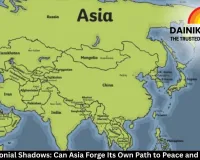Geopolitics in Flux: Why Central Asia Is Becoming China’s New Chessboard and India’s Strategic Test
Digital Desk

As Russia’s focus remains on Ukraine, China swiftly fills the Central Asian vacuum with economic and security deals. What does this power shift mean for India’s long-term interests in the region?
Being Good Is Not Enough—Being Careful Is the New Necessity
In geopolitics, goodwill is never a guarantee of security. The ongoing developments across Central Asia reflect this harsh reality. While Russia and China appear aligned today, the undercurrents tell a different story. Beijing’s quiet yet firm advance into Moscow’s traditional backyard is reshaping the power architecture of Eurasia—and India cannot afford to watch passively.
Russia’s Distraction, China’s Opportunity
Russia’s prolonged engagement in the Ukraine conflict has created a strategic vacuum in Central Asia—a region once called Moscow’s “soft underbelly.” As Western sanctions isolate the Kremlin, China has seized the moment.
President Xi Jinping’s recent visit for the 24th SCO Summit was only the visible layer. Beneath it, Beijing is signing bilateral security and economic agreements with Kazakhstan, Tajikistan, and Turkmenistan—nations that once looked to Russia for protection.
Through initiatives like the China–Kazakhstan oil pipeline and the Belt and Road Initiative (BRI), Beijing has converted infrastructure into influence. Central Asian trade data tells the story: over 20% of Kazakhstan’s and Uzbekistan’s foreign trade now flows directly with China, eclipsing Russian dominance.
The Great Game 2.0: Religion, Resources, and Realpolitik
Historically, Central Asia was the epicenter of the “Great Game” between the Russian and British Empires—a contest for control of India’s approaches. Today’s version pits China’s economic power against Russia’s residual military legacy.
The stakes are higher: vast hydrocarbon reserves, a growing risk of Islamic extremism, and the quest for strategic depth against Western influence. Beijing’s presence—masked under development aid, infrastructure loans, and counter-terror cooperation—has one core goal: ensuring stability in Xinjiang, its Muslim-majority border region.
India’s Balancing Act in the New Eurasian Order
For India, Central Asia represents both a historical connection and a strategic frontier. The region is critical for energy security, counter-terror cooperation, and connectivity projects like the International North–South Transport Corridor (INSTC) and Chabahar Port in Iran.
New Delhi’s challenge is clear: maintain engagement without antagonizing Moscow, while countering China’s growing footprint. By deepening defense cooperation with Tajikistan and expanding medical and IT partnerships in Tashkent and Astana, India is carefully positioning itself as a development-driven alternative to China.
The Return of Realism
Russia’s distraction, America’s withdrawal from Afghanistan, and China’s rise have collectively redrawn the Eurasian map. For India, “being good” is no longer enough; being strategic, cautious, and consistent is the necessity.
As the Great Game 2.0 unfolds, Central Asia remains the arena where China tests its reach, Russia defends its legacy, and India seeks its rightful place in the evolving order of Asian geopolitics.






.jpg)




